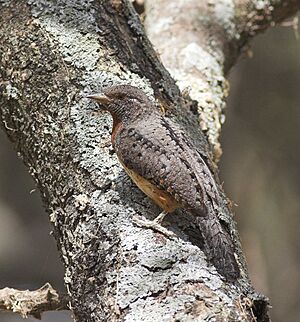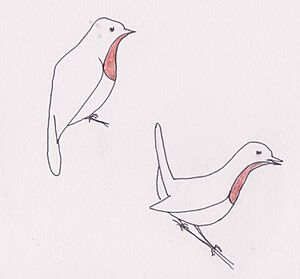Red-throated wryneck facts for kids
Quick facts for kids Red-throated wryneck |
|
|---|---|
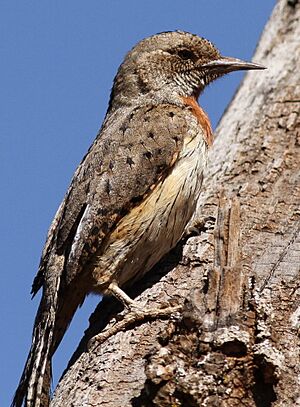 |
|
| Jynx ruficollis ruficollis in South Africa | |
| Conservation status | |
| Scientific classification | |
| Genus: |
Jynx
|
| Species: |
ruficollis
|
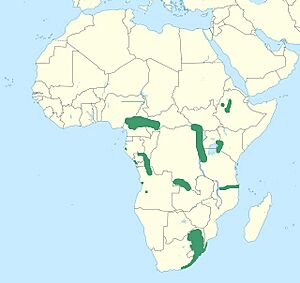 |
|
| Range map Resident | |
The red-throated wryneck (Jynx ruficollis) is a cool bird that belongs to the woodpecker family. It's also known as the rufous-necked wryneck or red-breasted wryneck. This bird is a close relative of the Eurasian wryneck. You can find its three different types, called subspecies, living in many parts of sub-Saharan Africa. They like open areas with some trees.
This bird is quite slim and long, about 19 cm (7.5 in) in length. It has a small head, a thin bill, and a long, fan-shaped tail. Its feathers are a mix of greys and browns, which helps it blend in with its surroundings. Male and female red-throated wrynecks look very similar. Their diet is mostly ants, from tiny eggs to adult ants. When a red-throated wryneck feels scared, it can twist its neck and head like a snake. It also makes a hissing sound to scare away animals that might try to hurt it.
The red-throated wryneck doesn't build its own nest holes. Instead, it uses holes that are already there, often in trees. It especially likes old nests made by barbets or other woodpeckers. The nest is usually 3 to 4 meters (10 to 13 ft) above the ground. A female typically lays three or four white eggs. Both parents take turns sitting on the eggs for 12 to 15 days until the chicks hatch. The young birds are fed by both parents for about 25 to 26 days until they are ready to fly. These birds usually have two groups of chicks each year. The red-throated wryneck lives in a very large area. Its population is big and growing, so it's considered a species of least concern by conservation groups.
Contents
- What's in a Name? The Red-throated Wryneck's Identity
- What Does the Red-throated Wryneck Look Like?
- Where the Red-throated Wryneck Lives and Its Home
- How the Red-throated Wryneck Behaves
- Life Cycle and Reproduction of the Red-throated Wryneck
- Who Hunts the Red-throated Wryneck?
- Red-throated Wryneck's Conservation Status
What's in a Name? The Red-throated Wryneck's Identity
Woodpeckers are an old family of birds. They include wrynecks, piculets, and true woodpeckers. Scientists have studied their DNA to learn how they are related. Wrynecks are a special group that likely separated from other woodpeckers a long time ago.
The group of birds called Jynginae has only one genus, Jynx. This name was given by a scientist named Carl Linnaeus in 1758. The Jynx genus includes two species: the Eurasian wryneck and the red-throated wryneck. These two wrynecks are very similar.
The red-throated wryneck was first described by a German bird expert, Johann Georg Wagler, in 1830. It's also known by other names like the rufous-necked wryneck or red-breasted wryneck. The name Jynx comes from an old Greek word for the Eurasian wryneck. The word ruficollis comes from Latin words meaning "red" and "neck." The English word "wryneck" describes how these birds twist their necks when they are upset. This name was first used in 1585.
The red-throated wryneck has three different types, or subspecies:
- Jynx ruficollis ruficollis (Wagler, 1830): This type is found in parts of southeastern Gabon, eastern Uganda, Kenya, Tanzania, Angola, Zambia, Mozambique, Eswatini, and eastern South Africa.
- J. r. aequatorialis (Ruppell, 1842): This type lives in the highlands of Ethiopia. It's also called the Ethiopian wryneck.
- J. r. pulchricollis (Hartlaub, 1884): You can find this type in Nigeria, Cameroon, South Sudan, and northwestern Uganda. It's also known as the bar-throated wryneck.
What Does the Red-throated Wryneck Look Like?
The red-throated wryneck is about 19 cm (7.5 in) long. Males and females look very much alike. However, males are usually a little bigger and heavier. They weigh about 52 to 59 grams (1.8 to 2.1 oz), while females weigh 46 to 52 grams (1.6 to 1.8 oz). This bird is slender and long, with a small head and a thin bill. Its tail is long and shaped like a fan. It doesn't look like a typical woodpecker.
Its feathers are patterned with greys, browns, and black, which helps it hide. Its upper body and head are brown with dark stripes. The lower back and upper tail feathers are grey with brown and black spots. The throat and chest of the Jynx ruficollis ruficollis type are red. Its lower chest and belly are white with some dark stripes. The sides of its body and the underside of its tail have a reddish-brown color. Its wings are brown on top and lighter underneath. The bill is grey and thin, its eyes are chestnut-colored, and its legs are grey. Like all woodpeckers, it has two toes pointing forward and two pointing backward. This helps it cling to tree trunks. Young birds look like adults after about 20 days. However, they are darker and have more stripes. Their red patch is smaller and darker.
The three subspecies look a bit different, mainly in how much red they have on their chest.
- Jynx ruficollis ruficollis has red from its chin to its chest.
- J. r. aequatorialis has red that goes further down its chest. It also has more reddish-brown on its sides.
- J. r. pulchricollis has a white chin and upper throat with brown stripes. Its red patch is darker and only on its lower throat and upper chest. This type also has more reddish-brown on its upper body.
It's hard to confuse wrynecks with other birds. However, some Eurasian wrynecks might spend winter in the same areas. The African red-throated wryneck usually has a clear red throat. It is also larger and browner overall. It does not have a dark stripe through its eye like its Eurasian cousin.
Feather Changes (Moult)
Most woodpeckers change their feathers (moult) once after they finish breeding. Wrynecks, however, have a partial moult before breeding. They also replace their tail feathers differently from true woodpeckers. This is because they don't need their central tail feathers for support, unlike woodpeckers that climb trees.
Bird Calls and Sounds
The red-throated wryneck's call is a series of harsh, loud notes. It sounds like kweek-kwik-kwee-quee. This call is usually slower than the Eurasian wryneck's call. It's a loud call that can be heard from far away. The bird makes this call from a high spot to mark its territory. It also has an alarm call that sounds like peegh followed by a repeated harsh krok. Young birds in the nest make soft squeaks at first. Later, they make a buzzing tsch sound. Both male and female birds make all these calls. However, the male's kweek call is deeper.
Wrynecks do not drum on trees like other woodpeckers. But they might tap near their nest hole or on branches. This seems to happen when two birds are interacting.
Where the Red-throated Wryneck Lives and Its Home
The red-throated wryneck lives only in sub-Saharan Africa. It can be found in about 20 countries. These areas are spread out from Nigeria and Ethiopia in the north to South Africa and Eswatini in the south. It doesn't really migrate, but it might move to different local areas after breeding. Sometimes, it visits Sudan, South Sudan, Zimbabwe, and Lesotho.
Its favorite home is open grassland with trees, especially acacia and miombo woodlands. But it also lives in other open woodlands, like the edges of forests. It can even live in places made by people, such as farms, parks, and gardens, as long as there are trees. These trees can include eucalyptus and conifers that were brought to the area.
You can find this bird at different heights, from 600 meters (2,000 ft) to 3,300 meters (10,800 ft) above sea level. In South Africa, it lives up to 1,550 meters (5,100 ft). In Kenya, it's mostly found between 1,400 and 2,500 meters (4,600 and 8,200 ft).
How the Red-throated Wryneck Behaves
The red-throated wryneck usually sits upright on a branch. Its tail and wings point down, and its head is pulled into its shoulders. When it calls, it raises its head and stretches its neck. When it's showing off to another wryneck, it leans forward. Its tail points straight up, and its bill is raised. It calls loudly and sways from side to side. If it feels threatened, it will twist its neck and head like a snake. It also makes a hissing sound. This is probably to scare away animals that might try to eat it.
Wrynecks fly by flapping their wings and then gliding with their wings closed. This makes their flight look bouncy, which is common for woodpeckers.
Pairs of wrynecks protect their territory, especially during the breeding season. One study showed that their territories can be from 8 to 24 hectares (20 to 59 acres). All these territories had groups of trees. They announce their territory all year by calling from high spots. The male usually does most of the calling.
The red-throated wryneck eats almost only ants. This includes ant larvae, pupae, and eggs. Sometimes, it eats termites and other small invertebrates. It catches its prey with its long, sticky tongue. Young birds eat the same ant-based diet. This wryneck usually feeds alone. About 90% of the time, it looks for food on the ground. It probes into ant hills. When it feeds in trees, it picks prey off the plants. It does not dig into the wood.
Life Cycle and Reproduction of the Red-throated Wryneck
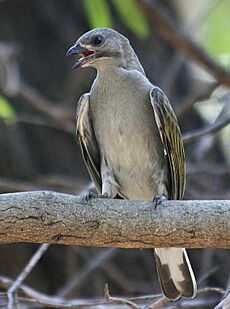
Like the Eurasian wryneck, the red-throated wryneck nests in holes that are already there. These holes are usually in trees. They don't dig their own holes. However, they might make a hole bigger if the wood is soft. They don't add any nesting material. They prefer old nests made by barbets or woodpeckers. They also use holes in fence posts and nest boxes. The wryneck has to compete with other birds for good nesting spots. The crested barbet is one bird it competes with. The nest is usually 3 to 4 meters (10 to 13 ft) above the ground. The hole is typically about 300 mm (12 in) deep. Nests can be reused in later years. Sometimes, they are used by other birds like violet-backed starlings in between. They also use them as places to sleep in winter.
A female lays between one and five eggs, but usually three or four. The eggs are cream-white. They are laid one day apart. Each egg measures about 22 x 16.5 mm (0.87 x 0.65 in) and weighs about 3.25 grams (0.11 oz). Both parents sit on the eggs for 12 to 15 days until they hatch. When they first hatch, the chicks are pink, naked, and can't see. But after about eight days, their eyes open, and their feathers start to grow. Both parents feed the chicks for 25 to 26 days until they are ready to fly. If someone comes near the nest, the chicks will hiss and move their heads like snakes. These birds usually have two groups of chicks each year, but sometimes up to four have been seen. The young birds become independent about two weeks after they learn to fly. The time of year they breed changes across Africa. Nesting happens in every month except June and July. In South Africa, about 57% of nests were successful. About 40% of eggs led to chicks that could fly.
There was one report of a mix between the two Jynx wrynecks in Cameroon. But later, scientists thought it was just a red-throated wryneck that looked a bit unusual.
Who Hunts the Red-throated Wryneck?
The red-throated wryneck can have tiny creatures called lice living on it. It can also get a disease from a parasite called Leucocytozoon.
Sometimes, other birds called honeyguides lay their eggs in the wryneck's nest. This is called brood parasitism. The honeyguide parents don't remove the wryneck's eggs or chicks. But their presence might attract other animals that hunt nests. Once a honeyguide chick hatches, it will kill the wryneck chicks. Wryneck chicks can also be killed if a crested barbet pair takes over their nest.
Scientists haven't studied much about what hunts wrynecks outside of Europe. In Europe, snakes might raid nests for eggs and young birds. The main bird threat to adult wrynecks is a type of hawk called Accipiter.
Red-throated Wryneck's Conservation Status
The red-throated wryneck lives in a very large area. Its population is big and getting bigger. Because of this, the International Union for Conservation of Nature (IUCN) says it is a species of least concern. This means it's not currently at risk of disappearing. In South Africa, it's common in many places. Its living area has even grown because people have planted non-native trees in grasslands that used to have no trees.



